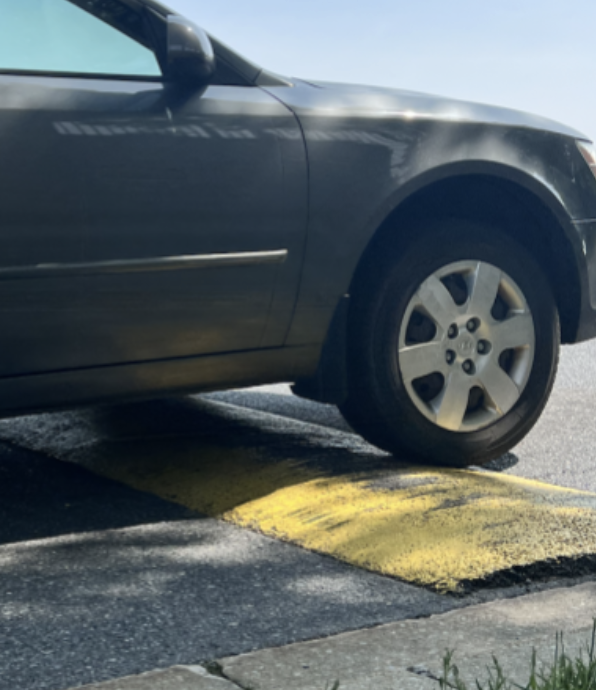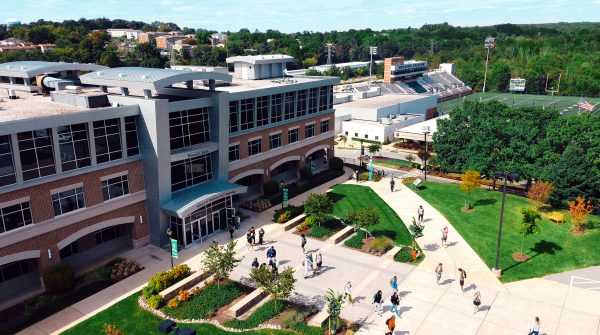BUMPS IN THE ROAD
New speed bumps coming to SU this summer; one student wants them lowered
Roadway obstructions. Speed-restricting nuisances. Adversaries of your vehicle’s underbelly. The sworn enemies of your oil pan. These are the infamous speed bumps that impede your desired driving velocity.
So why do we have so many here at Stevenson? And why are we adding more this summer?
According to Dean of Students Jeff Kelly, the introduction of brand-new speed bumps marks a significant milestone in prioritizing safety and ensuring a tranquil campus environment.
“The primary reason for adding speed bumps was to enhance the safety of the many pedestrians we have on campus,” Kelly said.
Sophomore Jordan Robinson said the speed bumps are OK, but they should be lower.
“My buddies and I have a low car,” Robinson said. “We can’t really drive on campus because of them.”

Robinson intends to initiate a petition to remove or reduce the height of the speed bumps on the campus. Speed bumps are designed to slow down vehicles by creating a raised portion on the road, which can be challenging for cars with low ground clearance to navigate smoothly.
The introduction of the campus speed bump project aims to promote safer driving and reduce speeds on campus, especially in areas with high pedestrian traffic. Despite the posted speed limit of 15 MPH, drivers often fail to comply, which is particularly concerning at locations with stop signs and pedestrian crosswalks.
To address this issue, additional speed bumps will be strategically installed on campus during the summer. These speed bumps will be placed at key locations such as the main gate entrances and exits, as well as along the access road to the residence halls. The project is expected to be completed by July 31.
According to the Occupational Safety and Health Administration (OSHA), speed bumps can help ensure the safety of pedestrians, especially in areas with high foot traffic, such as crosswalks and parking lots. By slowing down vehicles, speed bumps reduce the risk of accidents and provide a safer environment for pedestrians to cross roads or navigate campus.
Low cars, also known as sports cars or vehicles with a low ride-height, have a lower distance between the bottom of the vehicle and the ground. When these cars encounter speed bumps, their undercarriage, including the front bumper, rear bumper, or other components, may come into contact with the speed bump if it is too high or if the car is traveling at a higher speed.
The impact of a speed bump on a low car can cause several issues like scraping or damage, suspension damage, and exhaust system damage.
The low undercarriage of the car may scrape against the speed bump, leading to scratches, dents, or even structural damage. This can affect the aerodynamics of the car and may require repairs.
The sudden jolt experienced when driving over a speed bump can put a strain on the car’s suspension system. If the car’s suspension is not designed to handle such impacts, it can lead to damage or wear and tear on suspension components.
The low-hanging exhaust pipes or mufflers of some cars can be vulnerable to hitting speed bumps. If the car bottoms out on a speed bump, it can damage or detach the exhaust system, resulting in costly repairs.
“The only issue I have is, my car sits low and the speed bumps scrap against it. Sometimes I have to come to a dead stop and slowly go over them. With speed pumps, you can go at 15 miles per hour but not with these,” Campus Security Officer Joe Finch said.
To mitigate these issues, some drivers of low cars take precautions when encountering speed bumps, such as approaching speeding bumps slowly, taking alternative routes, and adding aftermarket modifications.
Cars can minimize the impact and decrease the likelihood of scraping the undercarriage or damaging components. If possible, drivers may choose routes with fewer or lower speed bumps to avoid potential damage to their low cars. Some car owners install aftermarket modifications like skid plates or raised suspension systems to increase ground clearance and protect their vehicles from scraping on speed bumps.
Stevenson’s initial speed bump was positioned on the incline connecting the Brown School of Business and Leadership to the Caves Sports and Wellness Center. Over time, two more speed bumps were introduced. To be precise, one was placed on the pathway that leads to the Caves parking lot, while the other was installed along the road linking Western Run and Rockland.

“The initial three speed bumps were strategically placed where motorists speeding has been observed or reported to Campus Safety and are in proximity to crosswalks to slow motorists down for pedestrian safety,” said James Mustard, the assistant vice president for facilities and campus safety.
The installation of speed bumps serves as a deterrent to speeding and encourages drivers to maintain safe speeds. In conjunction with this measure, the Campus Safety team will continue to enforce stop sign violations on campus. By implementing these initiatives, the university aims to improve overall road safety and prioritize the well-being of pedestrians.
Speed bumps can also be effective traffic calming measures to control the speed of vehicles on campus roads. Speed bumps encourage responsible and cautious driving by forcing drivers to slow down, preventing excessive speeding, and improving overall traffic flow.
“We’ve had numerous complaints about pedestrians nearly being struck by vehicles because drivers are running stop signs. They are planning on adding more speed bumps,” Campus Security Officer Joe Dubiel said.
Since there have been instances of speeding or accidents at Stevenson University, Dubiel said, the installation of speed bumps are a proactive measure to reduce the likelihood of future accidents. Speed bumps serve as a visual reminder for drivers to slow down and proceed with caution.
You may have observed some creative driving techniques employed to avoid speed bumps. However, is there a correct method for traversing speed bumps? Should you tackle them one wheel at a time, at an angle, or simply go slow? How fast should you drive over speed bumps?
Sun Devil Auto suggests going slow, ideally around 3 mph. Going over speed bumps at an angle does not provide any advantages for your vehicle, even if it is lowered. In either case, there is a risk of scraping the underside of your car. The most optimal and comfortable approach to negotiating a speed bump is to apply moderate acceleration or refrain from braking as you go over it.
Braking causes the front end of your vehicle to lower, while acceleration lifts it. To navigate a speed bump, slow down, release the brake before reaching the bump, accelerate once you reach the top, and maintain a straight trajectory. The straighter your vehicle is while traversing the speed bump, the better.
Despite the controversy surrounding the installation of speed bumps on campus, there is strong evidence to support the notion that speed bumps promote safety. By reducing speeds, increasing driver awareness, and improving pedestrian safety, speed bumps contribute to a safer and more secure environment for everyone on campus.
Your donation will support the student journalists of Stevenson University. Your contribution will allow us to purchase equipment and cover our annual website hosting costs.































































